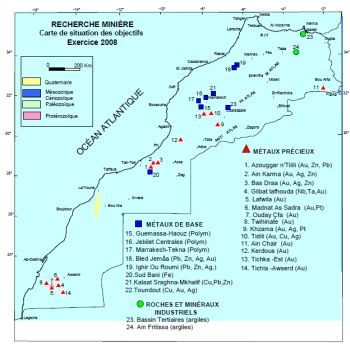
Uranium, diamonds, gold, niobium. ONHYM's mining programme in southern parts of occupied Western Sahara is speeding up. See where their projects are here.
In November 2008, the Moroccan state oil and mine company ONHYM wrote prospects for 3 different geological structures in southern Western Sahara.
Glibat Lafhouda
The geological finding, which was done in 2006, is located some 70 kilometers to the south west of Awserd.
The finding contains iron oxides associated with dolomitic carbonatites. An exploration programme was carried out in 2007 and 2008. It consisted of:
-14 bore holes
-850 samples done at an area of 5 sq.km.
-A topographic survey covering 4 sq.km.
-A geophysical survey (gravimetric and magnetometric) on a surface of about 10 sq.km.
See the prospect from 13 November 2008 in English or French.
Twihinate
The structure, located some 260 kilometers south of Dakhla, is claimed to be "susceptible to be a world class deposit for REE, Niobium and iron"
Download prospect here from 13 November 2008 in English - or in French.
Lafwila
The gold deposit in Lafwila is located 300 kilometers south of Dakhla.
A program of drill holes is under realisation.
See prospect from 13 November 2008 in English or French.
Tichla, Awserd
The fourth corner-stone of ONHYM's exploration of southern parts of Western Sahara, is the Tichla area, containing several interesting metals, as well as diamonds. It is explored through a joint-venture between ONHYM and Canadian firm Metalex. WSRW will write more about that partnership later.
In addition, there are two more stuctures in the region that ONHYM is exploring, the Madnat As Sadra and Ouday Cfa.

The map to the right shows the six projects in the southern part of Western Sahara. The map can be downloaded from this ONHYM report from October 2008. More details can be found in the prospects above.
It should be noted that the area in which the exploration is taking place, is under occupation, and that Morocco has no right to explore or exploit the minerals in the territory, as long as it is in the disregard of the wishes and interests of the Sahrawis.
After the International Court of Justice in October 1975 rejected Morocco’s and Mauritania’s claims to Western Sahara, the two neighbouring countries still decided to invade the territory.
The southern part, where the 6 exploration programmes are located, was first occupied by Mauritania. When Mauritania withdrew from the area in 1979, Morocco occupied it instead. The UN General Assembly reacted to the Moroccan 1979 occupation in Resolution 34/37 of 1979 (‘Question of Western Sahara’) paragraph 5, with the following statement: “Deeply deplores the aggravation of the situation resulting from the continued occupation of Western Sahara by Morocco and the extension of that occupation to the territory recently evacuated by Mauritania””, while paragraph 6 “Urges Morocco to join in the peace process and to terminate the occupation of the territory of Western Sahara”.
Download that resolution here.
Since then, the UN has stated that exploration or exploitation of the mineral resources in the area is in violation of international law if the local people has not given its consent, something which is evident that they have not.
The majority of the Sahrawi people has lived in refugee camps since Morocco illegally invaded the territory. The Sahrawis remaining under occupation, and who speak out for the independence, are subject to severe human rights violations. Morocco fails to respect the more than 100 UN resolutions that call for the right to self-determination to be respected.
More fake facts following Davidson & Company audit
Even after a likely intervention of the Canadian public accounting firm regulator, the mining company Metalex keeps misleading about its licences on occupied land in reports audited by Davidson & Company.
Goldak Airborne Surveys in controversy in occupied Western Sahara
The Canadian company undertook a airborne study of occupied Western Sahara on behalf of the occupying power.
Sander Geophysics did mapping in occupied Western Sahara
The Canadian company Sander Geophysics has been deeply involved in controversial airborne seismic studies in occupied Western Sahara.
Brazilian cement giant Votorantim behind sand plunder
WSRW was present as the Brazilian company Votorantim last week received a cargo of sand from occupied Western Sahara in Tenerife, Spain.

